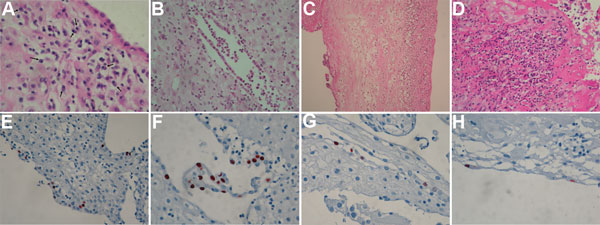Volume 20, Number 3—March 2014
Dispatch
Role of Waddlia chondrophila Placental Infection in Miscarriage
Figure 1

Figure 1. . Histopathologic analysis of placentas from women tested for infection with Waddlia chondrophila. A) Patient 140, chronic endometritis with various inflammatory cells in the deciduas, including plasmocytes (arrows) (original magnification x600). B, Patient 183, polymorphonuclear cells (PMN) in a an endometrial gland (original magnification x400). C) Patient 305, chorioamnionitis with PMN extending from the chorion to the amnios (original magnification x200). D) Patient 535, PMN in the subchorial fibrin near the gestational sac (original magnification x400). Hematoxylin and eosin stain. Immunohistochemical analysis showing W. chondrophila in placental tissue. A rabbit polyclonal antibody directed against W. chondrophila was used at a dilution of 1:12,000. Detection was performed by using the ChemMate Kit (Dako, Glostrup, Denmark). Negative controls contained antibody diluent instead of primary antibody. Negative and positive control pellets were included as described (10). All highly positive cells were found in epithelium of endometrial glands. E) Patient 535 (miscarriage) (original magnification x400). F) Patient 535 (original magnification x600) G) Patient 523 (miscarriage) (original magnification x600). H) Patient 250 (control) (original magnification x600). 3-amino-9-ethylcarbazole/peroxidase stain and hematoxylin counterstain.
References
- Regan L, Rai R. Epidemiology and the medical causes of miscarriage. Best Pract Res Clin Obstet Gynaecol. 2000;14:839–54 . DOIPubMedGoogle Scholar
- Carrington B, Sacks G, Regan L. Recurrent miscarriage: pathophysiology and outcome. Curr Opin Obstet Gynecol. 2005;17:591–7. DOIPubMedGoogle Scholar
- Baud D, Greub G. Intracellular bacteria and adverse pregnancy outcomes. Clin Microbiol Infect. 2011;17:1312–22 .PubMedGoogle Scholar
- Baud D, Regan L, Greub G. Emerging role of Chlamydia and Chlamydia-like organisms in adverse pregnancy outcomes. Curr Opin Infect Dis. 2008;21:70–6. DOIPubMedGoogle Scholar
- Baud D, Thomas V, Arafa A, Regan L, Greub G. Waddlia chondrophila, a potential agent of human fetal death. Emerg Infect Dis. 2007;13:1239–43. DOIPubMedGoogle Scholar
- Baud D, Goy G, Osterheld MC, Borel N, Vial Y, Pospischil A, Waddlia chondrophila: from bovine abortion to human miscarriage. Clin Infect Dis. 2011.
- Baud D, Goy G, Jaton K, Osterheld MC, Blumer S, Borel N, Role of Chlamydia trachomatis in miscarriage. Emerg Infect Dis. 2011;17:1630–5. DOIPubMedGoogle Scholar
- Goy G, Croxatto A, Posfay-Barbe KM, Gervaix A, Greub G. Development of a real-time PCR for the specific detection of Waddlia chondrophila in clinical samples. Eur J Clin Microbiol Infect Dis. 2009;28:1483–6. DOIPubMedGoogle Scholar
- Borel N, Casson N, Entenza JM, Kaiser C, Pospischil A, Greub G. Tissue microarray and immunohistochemistry as tools for evaluation of antibodies against Chlamydia-like bacteria. J Med Microbiol. 2009;58:863–6. DOIPubMedGoogle Scholar
- Kebbi-Beghdadi C, Cisse O, Greub G. Permissivity of Vero cells, human pneumocytes and human endometrial cells to Waddlia chondrophila. Microbes Infect. 2011;13:566–74 PubMed. DOIPubMedGoogle Scholar
- Baud D, Jaton K, Bertelli C, Kulling JP, Greub G. Low prevalence of Chlamydia trachomatis infection in asymptomatic young Swiss men. BMC Infect Dis. 2008;8:45 . DOIPubMedGoogle Scholar
- Haider S, Collingro A, Walochnik J, Wagner M, Horn M. Chlamydia-like bacteria in respiratory samples of community-acquired pneumonia patients. FEMS Microbiol Lett. 2008;281:198–202. DOIPubMedGoogle Scholar
1These authors contributed equally to this article.